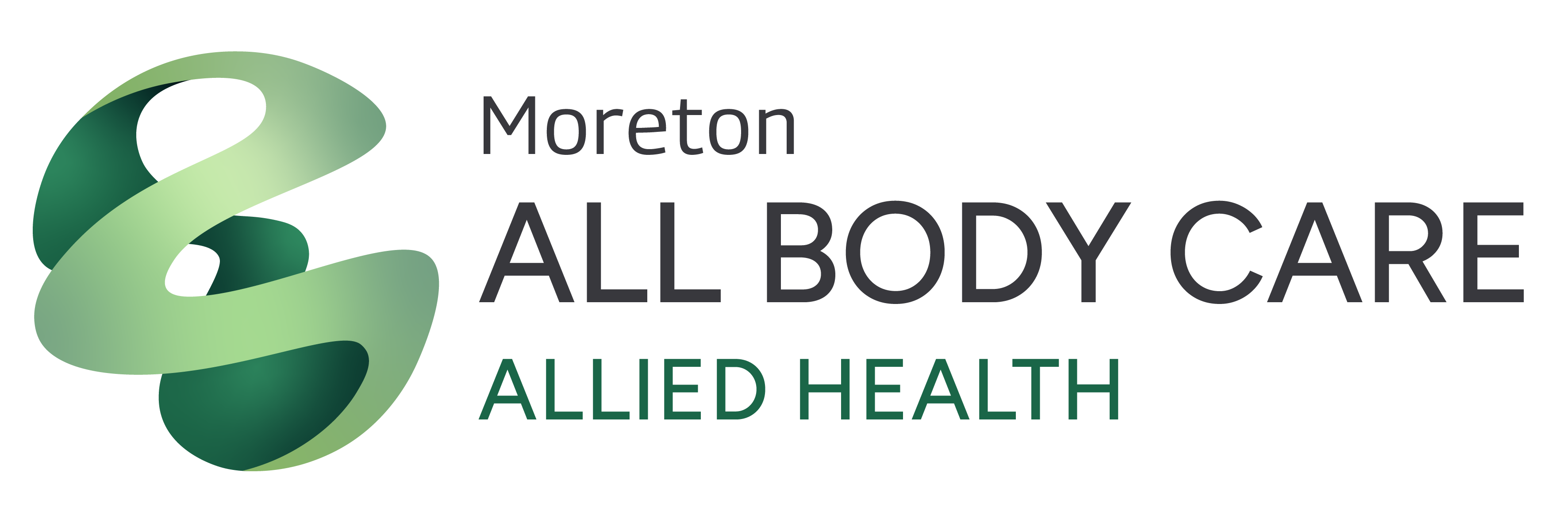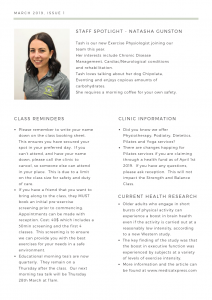The Cool Down – April 2019 Edition
Welcome to this month’s edition of The Cool Down – Moreton All Body Care’s monthly newsletter with practice information, staff profiles, exercises and even some tasty recipes for you to try.
What is the difference between your Allied Health Professionals? Who do I need to see?
We often find there is confusion amongst patients about who to see when booking an appointment. They are unsure exactly what it is our Allied Health Professionals do and how they are able to assist them with injuries and chronic health conditions.
Below is a brief overview of who Physiotherapists, Podiatrists & Exercise Physiologists are and also what they do in their scope of practice – hopefully this helps to clear up some of the confusion.
Physiotherapists
Physiotherapists are experts in the structure of the human body and its movement. They work with people of all ages to treat a broad range of health conditions including sports injuries and musculoskeletal conditions as well as chronic health conditions such as diabetes, obesity, osteoarthritis and stroke. Physiotherapists are involved in the assessment, diagnosis, planning and management of patient care.
Physiotherapists assess, diagnose, plan and manage the care of patients across a broad range of areas with musculoskeletal, cardiothoracic and neurological problems. They help patients with chronic disease management, provide lifestyle modification and self-management advice, prescribe aids and appliances, prescribe and supervise exercises for both patients and carers, and provide health promotion education, occupational health assessments and injury prevention activities.
Physiotherapists can help treat a range of chronic conditions, often as part of multidisciplinary teams. They are trained to design individual programs of care that help address risk factors arising from co-morbidities and physical limitations in people with chronic conditions.
Podiatrists
A podiatrist is an expert in foot care. Podiatrists help people in the care of their lower limbs including the foot and ankle and may also be involved in supporting older people to reduce their risk of falling.
Podiatrists provide a wide range of services from the treatment of calluses to the treatment of bone and joint disorders. For conditions such as recurring sprains and chronic pain, podiatrists may prescribe foot orthoses.
The podiatrist’s scope of practice includes areas such as paediatrics, diabetes, sports injuries, structural problems, treatment of the elderly as well as general foot care.
Podiatrists with additional qualifications and registration may also perform foot surgery.
Exercise Physiologists
Accredited exercise physiologists specialise in clinical exercise interventions for people with a broad range of health issues. Those people may be at risk of developing, or have existing, medical conditions and injuries. The aims of exercise physiology interventions are to prevent or manage acute, sub- acute or chronic disease or injury, and assist in restoring one’s optimal physical function, health or wellness. These interventions are exercise-based and include health and physical activity education, advice and support and lifestyle modification with a strong focus on achieving behavioural change.
Accredited exercise physiologists offer a range of services which include behavioural coaching, health education, exercise counselling and physical rehabilitation. Services include the prescription of tailored exercise programs, promoting leisure-time and incidental activity, and counselling to reduce sedentary behaviours. This will include an assessment to ensure the activity is safe, effective and likely to be maintained in the long term.
Accredited exercise physiologists do not provide invasive services (except for point of care testing), diagnosis, joint manipulation or pharmaceutical medicines.
So who do I see?
Some conditions may only require the intervention of one Allied Health Professional while others can benefit from a multi-disciplinary approach. At Moreton All Body Care it is always our goal to ensure that you are able to reach & maintain your optimum level of health and wellness.With this in mind, when you ring and make your first appointment with us, the more information you are able to provide us with at the time of booking, the better we are able to book you in with the appropriate professional.
Once you have had your first appointment, your treating practitioner will discuss with you your ongoing treatment plan and if, and when, you would benefit from seeing any of our other Allied Health professionals. Our Allied Health staff work closely together to ensure that your care and treatment is tailored specifically to your needs, and will work with you to achieve your specific goals.
Most importantly if you have any questions about any of our services, or about Allied Health in general, please feel free to ask us.
(Health professional information courtesy of https://ahpa.com.au/)
New Year, New You? Starting Exercise Safely
The New Year always brings with it a raft of resolutions and plans to live healthier and happier lives. Often some of these may revolve around exercising more or being more consistent in exercising. We love seeing people active in the community, and want to help people stay active, so we have compiled our 3 top tips on how to start exercising and avoid injury.
1- Start Slow
Our bodies are use it or lose it machines and because of this, especially if you haven’t exercised for more than 3 months or you have never exercised, it is important that you start slow. This allows the joints, muscles, connective tissue and bones time to get used to the load. Think of it like the “run in” period of a car. If you increase your workload by too much too soon it places you at a significantly higher risk of injury. A good rule of thumb is to make sure that you only increase exercise by 10-20% of what you have been doing over the past 4 weeks. I.E if you have been able to do 10 squats in a row, next week aim for 11-12, or if you have been able to walk for 10 minutes continuously aim to increase that to 11-12. Then gradually increase over time until you hit your goal.
2- Listen to your body
Your body will tell you when you have trained too hard or when you need to recover. This is important because the body gets stronger when it recovers and if you don’t allow your body enough time to recover then it won’t get as strong as possible. Practically, this may look like having an extra rest day when you are feeling fatigued or perhaps substituting an easy exercise session instead of a hard one if you don’t think you can cope with the hard session. As well as this, using foam rollers, self massage balls or stretching can help to keep your body in tip-top shape when you feel like you have tight muscles or stiffness.
3- Seek help early
Most issues are best managed in the early stages to reduce time off and make sure there are fewer barriers in your way to being healthy. Better than that is preventative medicine. This may involve making a plan with your doctor, personal trainer or exercise physiologist to make sure you avoid injury, or talking to a Physiotherapist about previous injuries or current injuries and modifications that need to be made. The most important aspect is that if you are unsure seek the opinion of qualified health professional to get an experts guidance on the best way forwards.
What does a Physiotherapist actually do?
Ever wondered what a physiotherapist actually does? Physiotherapists are professionals trained at assessing, diagnosing and treating a range of conditions and injuries to all areas of the body with the overall goal to improve function and reduce pain levels. At Moreton All Body Care we not only see people with sporting injuries and sore backs but also patients with repetitive strain injuries, neck pain or headaches, patients requiring rehabilitation after surgery or general muscular/arthritic/bursitis aches and pain. These can include workcover related, third party claims (e.g. motor vehicle accidents) and department of veteran affairs (DVA) patients.
During a standard 30min consult, physiotherapist’s conduct a range of special tests to determine the cause and contributing factors to your symptoms. Based on this they are able to advise you on the best treatment approach and provide manual therapy if appropriate. Follow up appointments are generally required to review your injury, and to progress your treatment and exercises as you get better. If this is the case the physio will discuss this with you. A medical certificate can be written if you require time off work or sport.
Treatment techniques commonly used include:
– Joint mobilisations to reduce stiffness and help restore any deficit to your range of motion. If your joints aren’t moving freely they become irritated and can be a cause of pain or place more load on surrounding structures which causes dysfunction. For example, your spine is made up of multiple levels (vertebrae) and if there is a stiff link it will change the way you move. Gentle manipulations can move and stretch the stiff area to get your joints moving again.
– Soft tissue techniques such as massage or trigger point release is an effective way of accelerating the body’s healing and recovery process by bringing more blood flow and oxygen to the area. It can relax tight or overworked muscles that are creating excessive stress on your joints.
– Prescription of individualised strengthening exercises to be performed at home to quicken your recovery.
– Stretches to lengthen tight muscles, stretch joints and/or help with posture correction.
– Pilates program development to improve strength, stability and flexibility. This can be matwork or reformer based.
– Dry needling (similar to acupuncture) of myofascial tissue. Points are stimulated to create local, spinal segmental or supraspinal pain modulating effects.
– Taping to restrict joint movement and minimise further structural damage to ligaments or muscles. Also used to improve biomechanics to address movement dysfunctions contributing to pain
– Education regarding your condition, appropriate rest required, activity modifications and load management strategies to minimise any further exacerbation of your condition. They are able to provide guidance as to whether scans (e.g. ultrasound, xrays, MRI) are required.
All treatment techniques are accommodated to your specific needs. It is never too early or late after an injury or onset of your pain to seek assistance by a physiotherapist. A referral by a GP is NOT required.






